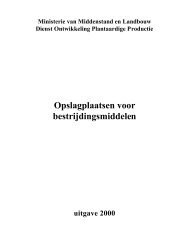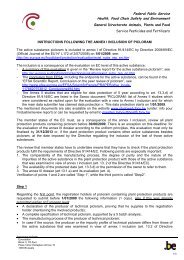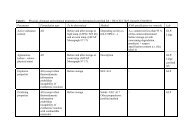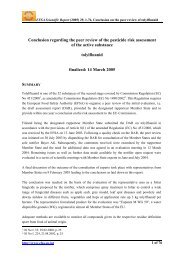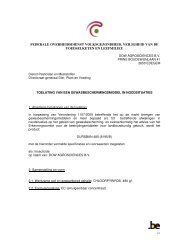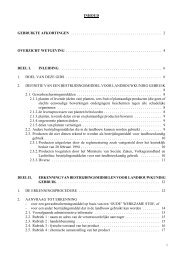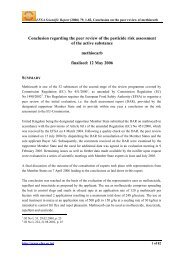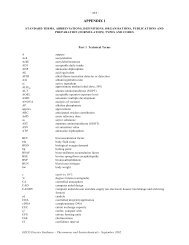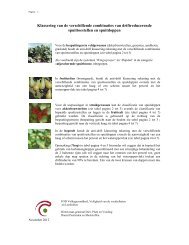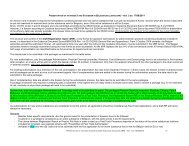Assessment of the Equivalence of Technical Materials - European ...
Assessment of the Equivalence of Technical Materials - European ...
Assessment of the Equivalence of Technical Materials - European ...
- No tags were found...
Create successful ePaper yourself
Turn your PDF publications into a flip-book with our unique Google optimized e-Paper software.
Appendix VI Example calculations for applying <strong>the</strong> generic approach for assessingecotoxicological equivalenceExample A: The new source <strong>of</strong> a herbicidal active substance contains an impurity with acontent <strong>of</strong> 5 %, which was contained in <strong>the</strong> batches for <strong>the</strong> algae test at an amount <strong>of</strong> 2 %.With <strong>the</strong> parameters f = 10, p old (A) = 0.02 und p new (A) = 0.05, <strong>the</strong> relation <strong>of</strong> predictedtoxicity to <strong>the</strong> known effect value is calculated as follows:ECECx( mix old)( mix )xnew=( f − 1) × pnew( A)( f − 1) × p ( A)old+ 1 9 × 0.05 + 1 1.45==+ 1 9 × 0.02 + 1 1.18= 1.23The increase in toxicity is not serious (< 2); <strong>the</strong>refore, no fur<strong>the</strong>r investigations are necessaryfor this area <strong>of</strong> risk assessment.Example B: The specification <strong>of</strong> a herbicidal active substance contains an impurity with acontent <strong>of</strong> 7 %, which was contained in <strong>the</strong> batches for <strong>the</strong> fish test at an amount <strong>of</strong> 1 %. Theeffect concentration (LC 50 ) in this study was determined as 2000 µg/L.A specific action <strong>of</strong> <strong>the</strong> herbicidal active substance on fish cannot be assumed; hence, a factorf = 100 must be applied in <strong>the</strong> calculation.ECECx( mix old)( mix )xnew=( f − 1) × pnew( A)( f − 1) × p ( A)old+ 1 99 × 0.07 + 1 7.93==+ 1 99 × 0.01+1 1.99= 3.98The toxicity predicted for <strong>the</strong> new source is seriously (> 2) higher than <strong>the</strong> known effect valuefor <strong>the</strong> tested batch. Thus, <strong>the</strong> representativeness <strong>of</strong> this source cannot be substantiated withsufficient certainty for <strong>the</strong> existing fish study; an appropriate bridging study is required toprove <strong>the</strong> ecotoxicological representativeness <strong>of</strong> <strong>the</strong> specification.Example C: A measured effect value for an LC 50 <strong>of</strong> 400 µg/L is known for <strong>the</strong> impurity inexample B. Thus, <strong>the</strong> factor f, which describes <strong>the</strong> higher toxicity <strong>of</strong> <strong>the</strong> impurity as comparedto <strong>the</strong> pure active substance, can be calculated and be used in <strong>the</strong> equation for estimating <strong>the</strong>extrapolated toxicity.( B)( A)( mix old) − pold( A) × EC x( mix old)( A) − p ( A) × EC ( mix )EC xEC x2000 − 0.01×2000 1980f = === = 5.21EC EC400 − 0.01×2000 380xxoldx(i.e. an LC 50 <strong>of</strong> 5.21 × 400 = 2084 µg/L is derived for <strong>the</strong> pure active substance)oldECECx( mix old)( mix )xnew=( f − 1) × pnew( A)( f − 1) × p ( A)old+ 1=+ 14.21×0.07 + 1 1.29=4.21×0.01+1 1.04= 1.24Taking into account <strong>the</strong> experimentally determined effect value for <strong>the</strong> impurity A, <strong>the</strong>increase in toxicity <strong>of</strong> <strong>the</strong> new source is not serious (< 2); hence, no fur<strong>the</strong>r investigations arerequired in this area.



